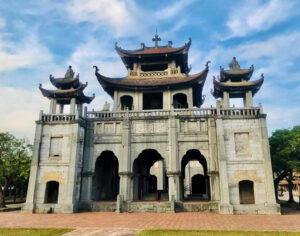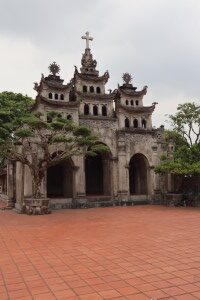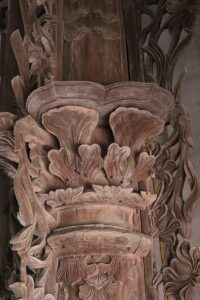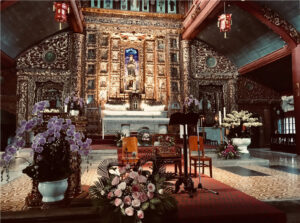Renowned author Graham Greene once famously described Phát Diệm Cathedral as “more Buddhist than Christian”. The Cathedral is a stunning blend of East and West architecture, culture, art and religion located in the southern district of Kim Son in Ninh Binh province.
Local workers chiselled, transported, and shaped local mountain rock to build the core structure of the cathedral as a testament to the glory of God and human inventiveness. Although the official date of its consecration was 1892, in reality, it took some 24 years between 1875 and 1899 to complete the construction.
Uncle “Six”
The Cathedral complex covers 22ha and includes several grottoes, an impressive 4 ha lake, immaculately maintained gardens and a multitude of statues, carvings and relief work. Fr. Tran Luc (1825–1899) designed and led the work, and his grave lies in the forecourt of the cathedral.
Father Tran Luc, originally known as Tran Van Huu, was from nearby Thanh Hoa province and went by many names during his life. Despite being neither an architect nor a builder, he successfully turned his dream into reality as one of the most beloved and admired Cathedrals in all of Vietnam. Parishioners of Phat Diem colloquially called him Cu Sau (Uncle Six). Others thought of him as a turncoat for his close alliance with the French Colonial forces. However, he persevered against all odds and eventually achieved his vision.
The Cathedral’s most notable feature is its construction solely from stone and wood. However, it also distinguishes itself by adhering to traditional Vietnamese architecture for temples, pagodas, and palaces. Inside the Cathedral, the ornate altar, adorned with gold, is reminiscent of the style of a Roman basilica, but with a distinctly Vietnamese flavor.
At the time of writing, the Ninh Binh provincial government is working with Japanese researchers to complete an application for UNESCO. It proposes the unique architecture of Phat Diem and its remarkable history as deserving of listing as a world cultural heritage site. Certainly, aficionados consider it one of the most beautiful churches in the country and often refer to the area as the “Catholic capital of Vietnam.”
A Troubled Beginning
Located around 120km south of Hanoi and perhaps 30km from Ninh Binh City center, Father Peter Tran Luc practiced during a time of heavy repression of the Catholic Church by local rulers. Indeed, in 1857, King Tu Duc issued four consecutive decrees banning the religion following French incursions at Da Nang. The authorities completely razed the Vinh Tri minor seminary, where Fr. Tran Luc studied, along with several other Catholic institutions, and martyred many Vietnamese Catholics.
The Nguyen authorities exiled Fr. Tran Luc and his brother for a time in Lang Son. However, on his return in 1865, Bishop Jeantet Khiem appointed him parish priest of three small districts south of Hanoi. Several years later, in 1871, he organized his parishioners to build a small church in Trung Dong village, now part of Yen Mo district in Ninh Binh Province.
In 1873, Francis Garnier a French Naval Officer and Explorer, attacked Hanoi and occupied Nam Dinh, Ninh Binh, Hai Duong and Hai Phong. This precipitated the Tonkin Incident where French forces attacked and conquered the Hanoi Citadel. Fr Tran Luc was part of the negotiating party which saw France withdraw, the Citadel reclaimed and Garnier to lose his life.
Finally finding favor with the Vietnamese court, Fr Tran Luc moved the parish headquarters to Phat Diem. Receiving funding from both Hanoi and the French, he then began construction of what would eventually become the Phat Diem Cathedral. The authorities designated Phat Diem Cathedral as the bishopric of Thanh Diocese in 1901 and renamed it as the Phat Diem Diocese in 1960.
Construction
To carry out the construction, workers sourced wood from the provinces of Nghe An, Thanh Hoa, and Son Tay. They quarried the base stone from Thien Duong Mountain, about 30 kilometers from Phat Diem, while the more decorative stone came from Nhoi Mountain in Thanh Hoa Province, another 60 kilometers away. Workers loaded the raw wood and stone onto local rafts and barges and floated them downriver. When they arrived, they waited for the tide to rise so they could unload the materials at the wharf..
This monumental effort by Fr. Tran Luc aimed to unite Catholicism with traditional Vietnamese architecture and to express the faith’s deep solidarity with the nation’s culture and history.A remarkable achievement by a remarkable man.
The Cathedral complex consists of several important features. As you approach the church from Phat Diem town, it’s hard to miss the 4-hectare rectangular lake, bordered by stone embankments. At its center lies a man-made island that holds a large stone statue of Jesus.
Architecture
Continuing on is the Phuong Dinh Bell Tower, also known as the “Square House”, a three storey building 25 meters high, 17 meters wide and 24 meters long completed in 1899. Many regard Phuong Dinh as the masterpiece of the complex, built entirely from heavy stone and wood transported from around 40 kilometers away. An impressive feat in an era without motorized transport.
The four turrets and central tower, topped with high, pointed, tiled “boat” roofs, reflect the style typical of Vietnamese pagodas. Indeed, at first glance many people mistake Phuong Dinh for a Vietnamese stupa or pagoda, as its turrets display stylized statues of saints and its entrance showcases the iconic triple-arched gate of traditional Vietnamese architecture.
Builders paved it with large green stone slabs, placed a man-made grotto at its center, and adorned its walls with masterful stone reliefs depicting Jesus’s journey into Jerusalem. On the second floor of Phuong Dinh hangs a large drum, the Vietnamese equivalent of a bell which sounds in times of trouble, jubilation or warning.
The Phat Diem Bell
The third floor hangs the building’s eponymous bell – 1.4m high, 1.1m in diameter and weighing nearly 2000kg. Cast to order in 1890, the bell rings twice daily – at 5 a.m. and 5 p.m. – to call the faithful to prayer. Graham Greene, author of The Quiet American, famously linked Phuong Dinh when he used the tower to observe the bloody battle between French colonial forces and the Viet Minh resistance in Phat Diem in December 1951.
The cathedral itself, a massive 74-meter-long wood and stone structure, was consecrated in 1891 as the Church of Our Lady of the Rosary. With four roofs and five entrances under carved stone arches, inside there are 6 rows of solid ironwood columns (48 in total). The center two rows are some 11m high and 2.35m in circumference, each milled from a single tree and estimated to weigh about around 7 tons.
Interior Design
The centerpiece is the cathedral’s main altar, carved from a single piece of ironwood. Measuring 3 meters long, 1 meter wide, and 1 meter high, and weighing around 20 tons, it features incised flowers symbolizing the four seasons. This altar stands as a spectacular achievement of logistics, artistry, and beauty.
On either side of the church there are four more, smaller chapels independent of the main building but using similar materials and style. Father Trần Lục oversaw the construction of the Church of the Immaculate Heart – the first church on the site – between 1883 and 1889. Constructed entirely from local stone and situated to the northeast of the cathedral, it is locally known as the “Stone Church”.
As time passed, builders added several chapels. Saint Roco’s Church (1895) in the southeast, Saint Joseph’s Church (1896) in the southwest, and Saint Peter’s Church (1896) in the northwest. They constructed all of them using local stone and, except for the “Stone Church,” incorporated massive ironwood beams and intricately carved fittings.
Grottos
The architects constructed three artificial caves (grottoes) about 100 meters apart to the north of the church, carefully designing them to maintain a “natural” appearance. In keeping with the Vietnamese tradition of “water in front, mountains behind,” they encased each grotto in artificial mountains.
The oldest of the three is Burial Mountain, built in 1875. The second and arguably the most popular is Mount Lourdes. Builders originally constructed it in 1896 and named it the Garden of Gethsemane but in 1925, they renamed it to Birthday Mountain. Skull Mountain is the final edifice, built in 1898 and originally called the cave of Bethlehem. However, in 1957, when locals erected a statue of the Crucifixion, the site became known as Skull Mountain.
Visitor Advice
Over the past 130 years, Phat Diem Cathedral has survived many wars and natural disasters. Today it remains a place of worship for local and foreign Catholics while preserving a unique and beautiful meld of Western Religion and Eastern Architecture. Visitors are free to visit and take photos however, like any place of worship, should take note of the following:
- Dress modestly, appropriate for the sacred place.
- Do not gather in large numbers, laugh and talk loudly, affecting the solemn and nostalgic atmosphere of the church.
- If you take pictures, check that they are in accordance with local customs and traditions, without infringing on the relics.
We strongly encourage visitors to wear sturdy footwear when exploring the expansive cathedral complex.. You should also bring any accessories such as hats, sunglasses, and umbrellas to protect against the often unpredictable weather.
The usual assortment of tours, taxis, buses and Grab rides are available but it is a considerable distance from Ninh Binh city so prices will reflect that. Self-drive by motorbike or car is easy along a busy main road. There are a number of cafe and restaurant in the nearby bustling town of Phat Diem and several souvenir and small good shops within the cathedral grounds. Remember that the Cathedral is very much still a place of religion and the main chapels are not open to tourists. However, entry is possible for the faithful during the posted signs for mass and other religious services.







